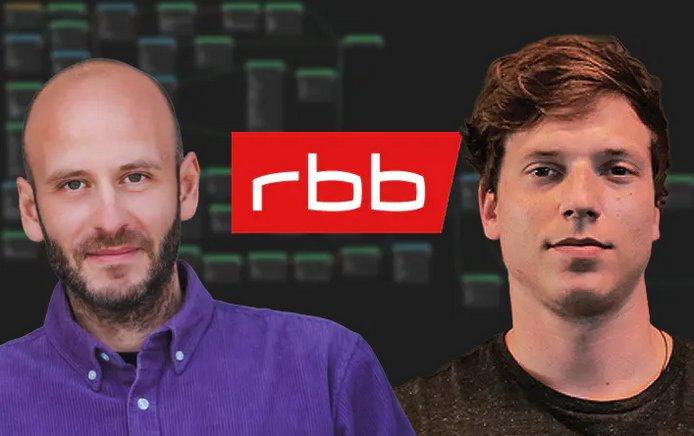
Workflow automation at rbb with Helmut4
Post-production at Rundfunk Berlin-Brandenburg is undergoing a profound change. Adobe Premiere Pro is replacing the previous dual system as the central editing solution – supplemented by the workflow management tool Helmut from MoovIT. This is accompanied by organizational and technical restructuring that is noticeably changing the way the broadcaster works.
Carl Förster and Patrick Westphal-Techen, both now content managers and supervisors in rbb’s cross-media news center, are among the architects of this transformation. Helmut provided the two former content creators from editing, directing, and outside broadcast vehicles with a “toolbox” that they used to simplify and automate their respective areas of work in editing, graphics, file management, operational administration, and quality checks for themselves and their colleagues. After intensive training from MoovIT, they built their first workflows and developed a deep understanding of the potential of the new infrastructure. Today, they are more than just operational administrators – they act as technical translators between the editorial team and the system world. “In the past, we were mainly busy with troubleshooting and file transfers,” recalls Förster. "Today, we develop processes that take real work off our colleagues‘ hands.
The changeover is therefore not just a change of system, but also a cultural shift. Role profiles are changing, responsibilities are shifting, and editing and production are moving closer together. “In the past, the technical department built what the editorial department wanted. Today, we build together,” explains Westphal-Techen. This brings greater agility – including in support. “When a new production request comes in today, we no longer have to open a ticket with Adobe. We often build the workflow ourselves and solve problems instead of asking IT for help.” Long support wait times are a thing of the past.
Automation instead of manual work
What used to have to be done manually in Premiere—such as project creation, entering user-specific keyboard shortcuts, setting up workspaces, integrating graphic elements, or selecting the right export profiles—is now automated by Helmut in the background. As soon as a user connects, their personal Premiere settings are loaded, a standardized project with a predefined layout and motion graphics is opened, and all audio and video paths are configured correctly. The projects are no longer only available locally, but also across locations via the Helmut server. The switch to Adobe Premiere presents a number of technical challenges for rbb. Depending on the target platform, audio routings must be adjusted, proxy workflows automated, project templates maintained centrally, and broadcast-ready export formats generated. The right image levels are also crucial for linear playout. All these parameters are controlled centrally by Helmut and applied automatically for each production.
A particularly practical example is the workflow for voice recordings: editors can have their Premiere projects automatically transferred to a sound booth, where the sequence is already open when they arrive. “This saves precious minutes in everyday news production,” says Westphal-Techen. Export processes have also become significantly more efficient: separate streams have been created for social media platforms such as BlueSky, which automatically take formats and file sizes into account. “One click is all it takes – and the contribution is generated exactly according to platform specifications,” says Förster. Even warning systems for excessive length are integrated.
In the video, experts from rbb explain the necessary post-production steps with and without automation by Helmut and the associated time savings.
Editing, editorial, and systems come together
All this is made possible by Helmut’s Streamdesigner: a graphical user interface that allows workflows to be set up in a modular and flexible way. “The entry barrier is relatively low. You graphically connect nodes that trigger specific functions,” explains Förster. “If you want to go deeper, you can even add JavaScript later to implement more complex logic.” “With Helmut, you can build streams and make adjustments at short notice. This makes us the masters of our workflows and a center of excellence for post-production. With Helmut, we can do things that we couldn’t do before or that would have required much more complicated technical solutions. Today, IT sometimes asks us for support because solutions are easier with Helmut.”
Despite all the advantages, the transition is not a sure-fire success. Experienced editors who have worked with a legacy system for a long time want familiar processes and functions. Standards, clear structures, and support from the internal team help here. “Our goal is to offer the same level of comfort as before—while creating new opportunities at the same time,” says Westphal-Techen. The fact that the new system runs stably despite its complexity is a decisive factor: “The need for support is low, and confidence is high.”
The integration of Helmut is not limited to the editing environment. The rbb system landscape has also been consistently connected: content can be exported directly from the Helmut panel to VPMS 2.0, Digas?!, the online CMS Adobe Experience Manager (AEM), ProTools, or Swat.io. “Helmut is the glue that holds everything together,” says Förster. The transfer of contributions is media-neutral, automated, and—above all—reliable. IDs and status messages flow back into the system, reducing manual effort.
Even non-native Helmut Premiere workflows, such as the interview tool or an automated archive workflow, can be configured via the Streamdesigner.
Shaping change instead of managing it
The fact that such workflows can be developed in-house is a strategic decision at rbb. “We wanted to be independent, not a black box,” emphasizes Westphal-Techen. That’s why rbb specifically relies on internal expertise rather than external service providers. This requires a team with an interest in technology, an understanding of post-production processes, and perseverance. “You grow into it, step by step,” says Förster. “The system is logical – if you work with it regularly.” For the deep backend area – such as the server structure – rbb also has its own Helmut administrators.
For other media companies planning similar steps, the rbb team recommends a phased approach: understanding post-production and technical processes, training with the tool provider, and gradually expanding skills. After all, the combination of Adobe Premiere and Helmut offers enormous potential – if used correctly.
“Now may be exactly the right time to shed old burdens,” says Förster. “Now that we’re setting everything up from scratch anyway, we can build the systems the way we really need them.” There will never be a perfect setup – but the current one comes pretty damn close.
MoovIT, a company of the Avemio Group, provides video and IT solutions for broadcasters and organisations of all shapes and sizes. The company, headquartered in Cologne, specialises in the development and support of workflows for all aspects of post-production, news and archiving at the interface between video and IT. MoovIT leverages particular expertise in the field of technical solutions for collaborative production environments such as sports reporting.
In addition, the company develops web-to-video solutions, localisations, remote editing systems, video hosting products and cloud services used by organisations across a highly diverse range of industries.
MoovIT Software Products (MSP), a subsidiary of MoovIT GmbH, has been founded to focus on development tasks relating to MoovIT’s standard software brands, such as the Helmut portfolio.
MoovIT’s customers include broadcasters, production companies, sport event organisers, agencies, and enterprises from a wide range of backgrounds.
In short, MoovIT is the perfect partner for worldwide support, managed services, software, hardware and integration solutions that accelerate and streamline processes – what we call WORKFLOW IN THE FLOW.
MoovIT GmbH
Schanzenstr. 29
51063 Köln
Telefon: +49 (221) 30200210
Telefax: +49 (221) 30200299
http://moovit.de
Marketing
E-Mail: a.vinkemeier@moovit.de
![]()



